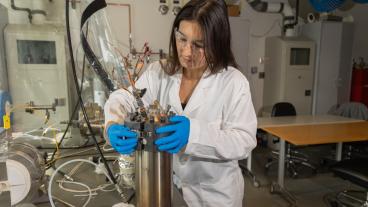USGS, Colorado School of Mines establish joint industry program to explore potential of geologic hydrogen

Colorado School of Mines (Mines) and the U.S. Geological Survey (USGS) have established a joint industry program supported by leading international companies in the energy industry to study the potential of a low-carbon alternative energy source: geologic hydrogen.
“We have a perfect opportunity to merge our scientific expertise in Colorado School of Mines and the USGS to tackle this exciting potential new addition to the alternative energy mix,” said Geoffrey Ellis, a research geologist with the USGS Energy Resources Program and director of the new joint program.

“This is the first collaborative effort on geologic hydrogen between a federal agency and academia,” said Mengli Zhang, co-director of the Center for Gravity, Electrical and Magnetic Studies and co-lead of the new joint program for Mines. “With the combined expertise in electromagnetics, gravity and magnetics in mineral exploration and exploration seismology for natural gas at Mines, we are uniquely positioned to tackle the subsurface exploration research in geologic hydrogen.”
Geologic hydrogen is a naturally occurring gas with significant potential as an energy resource. It is also a resource that could help reduce the climate impact of many industries that cannot easily be electrified – everything from heavy duty transport (air travel) to steel manufacturing to industrial heating.
Most hydrogen today, however, is manufactured using natural gas, requiring large amounts of energy and releasing carbon dioxide that is often left unabated. Current methods for reducing the carbon footprint of producing hydrogen include capturing and storing the carbon dioxide produced, or by using renewable electricity to split water molecules – both more costly than traditional hydrogen manufacturing.
As an alternative, scientists with Mines and the USGS have begun investigating the hydrogen gas that naturally exists beneath the surface of the Earth. Preliminary research suggests that vast quantities of hydrogen may exist in various rock formations, both in the United States and around the world.
In the first industry-supported hydrogen exploration consortium in the world, researchers at Mines and the USGS will advance the understanding of geologic hydrogen systems, as well as develop surface- and subsurface exploration technologies to locate the clean-burning gas beneath the ground.
“Fortunately, we are not starting from scratch here,” Ellis said. “We can adopt and adapt the learning that we have developed from many decades of research into other resources such as mineral resources, petroleum and geothermal energy.”
To that end, the consortium’s research will focus on the development of four key areas:
- A geologic “hydrogen system” model that identifies sources, migration pathways and mechanisms, reservoirs, traps and seals leading to accumulations of hydrogen in the subsurface.
- Surface exploration approaches, including remote sensing and surface geochemistry, to refine our understanding of where hydrogen accumulations exist in the subsurface.
- Subsurface exploration tools, including multiple geophysical tools, advanced signal processing and artificial intelligence tools, to image geologic hydrogen systems and potential economic accumulations suitable for energy production.
- 3D reactive transport modeling that integrates geology, geochemistry and geophysics to improve the understanding of hydrogen systems and provide guidance to the development of exploration strategies.

“A major focus of the consortium is developing immediately deployable technologies,” said Yaoguo Li, professor of geophysics at Mines. “There’s a need and desire for exploration technologies that can be applied by industry in the near future to contribute directly to the energy transition, as well as for strategies that can be used by society to tackle the challenges in mitigating climate change for better human life.”
Funding for the research will come from a growing number of industry partners. Eight member companies have already signed on, including major players in the mining and energy industries and geologic hydrogen start-ups: BP, Chevron, Eden Geopower, Petrobras, Fortescue, Koloma, Hydroma USA, and HyTerra.
The consortium began collaborative research between Mines and USGS scientists in September 2023. The immediate objectives are the scientific understanding of hydrogen systems, including mechanisms and conditions of hydrogen generation, migration, and preservation, as well as practical tools to find hydrogen accumulation and identify the potential for enhanced hydrogen generation. The consortium will also emphasize educating researchers and engineers in this emerging field.
Mines’ involvement in the consortium is being led by Research Assistant Professor Mengli Zhang and Professor Yaoguo Li of the Department of Geophysics. The Department of Geology and Geological Engineering is also involved.
The USGS’s involvement is led by Geoffrey Ellis, with support from the USGS Energy Resources Program.
More information on the consortium can be found here. More information on geologic hydrogen can be found here.
MEDIA CONTACTS
Emilie Rusch, Director of Communications, Colorado School of Mines, erusch@mines.edu
Allie Weill, Office of Communications and Publishing, U.S. Geological Survey, aweill@usgs.gov




